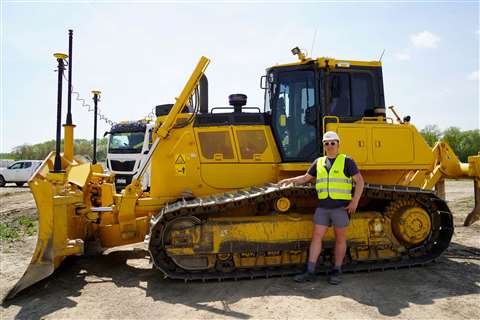From automation to autonomy
23 November 2022
Long gone are the days of manually checking grades and positioning machinery by hand. Now, the words ‘machine control’ are well known in the industry, in addition to other buzzwords – efficiency, profitability, quality, safety and sustainability – echoed in company workbooks, mission statements and break-room collateral. Technology introduced in the last 10 years has provided a means to hit more of these buzzwords for the greater good of the industry.
 Magnus Thibblin, President, Machine Control, Hexagon Geosystems division. Photo: Hexagon Geosystems
Magnus Thibblin, President, Machine Control, Hexagon Geosystems division. Photo: Hexagon Geosystems
As we look down the winding path toward the future construction site – one that carries bigger implications and challenges in terms of sustainability – it’s clear that we need to reduce the expense and complexity that current automation is providing.
For this, construction solutions must be reimagined to truly transform the industry. Technology is no longer just about referencing positions of cutting edges. It’s about bringing in hardware and software for the greater good of not just the industry, but society as a whole. Autonomy is the answer.
Starting with machine control
Machine control is a subtle and often invisible process of automation. It enables enhanced location referencing that provides accurate horizontal and vertical positioning for precise grading, milling or paving. This is made possible thanks to GPS satellites and more recently, robotic total stations, lasers, or a combination of these methods.
Machine control automation for the guiding of construction equipment has undeniably improved accuracy industry-wide. The market is currently in a position of semi-automation and automation – automating everything from the site machines themselves to the movement of data between the machines and the office.
What’s great about semi-automated solutions is that they require fewer people on-site and help to address the industry’s shortage of skilled labour. I expect such applications to only grow in speed, enable more accuracy and become easier to use as new solutions hit the market. For example, we are working on solutions that facilitate data checking and validation, creating processes while removing errors. The unison of data and machines is critical for autonomy.
Autonomy improves safety and sustainability
There are two global concerns in the heavy construction industry; safety and sustainability. We’ll start with the longest-standing concern; safety. While it’s always been a concern, it’s being felt increasingly with an influx in machinery on the construction site. Of course, autonomy would imply an unacceptable safety risk if it wasn’t for the sensors supporting operators and protecting people working around heavy machinery.
That’s why we focus our efforts on enhancing driver awareness and helping operators see things around them, building solutions that can save lives. For example, we have solutions that grant on-site awareness with alert signals that indicate when operators are nearing a car or truck – so the operator can stop ahead of time. Ultimately, our aim is to integrate this compound of machines into an ecosystem of safety awareness. And as we are already connecting entire sites, a future with this ecosystem is something we can expect.
Of course, the most dominant concern in the heavy construction industry is sustainability, and with great reason. The construction industry represents 13% of worldwide gross domestic product (GDP). The sheer figures of CO2 emitted and the resources consumed are astronomical. If we made a 1% improvement in CO2 reduction through fuel efficiency, transportation and other means, we could have a direct reduction of 0.12 gigatons of CO2 per year. To set the scene, there are over four million miles of road in the US alone.
If we can make a 1% improvement in recycling existing asphalt through new reconditioning methods, such as precise milling or 3D machine control when laying asphalt to reduce wasting unnecessary hot asphalt mix, we could make that saving. Although it seems minor, a 1% change is significant in our industry. We must act now.
Putting data to work
With autonomy, the difference is not just about having new technology. It’s about having technology that produces data and puts it to work. You could argue that there is no autonomy without real-time access to data, which is crucial for fuelling the decision-making process. Autonomy means equipping machines, people and assets with sensors, cameras and connecting the entire site with the cloud utilising integrated software solutions to enable project managers, site foremen and operators to make quicker and better decisions.
The real-time transfer of data from the field to the office, and vice versa, is the key ingredient to ensure that everyone can access the right data, the second they need it. Capturing more data points with the use of various sensors is tremendously valuable, but extracting the right information and generating insights will become essential on the journey towards autonomy.

And then there are the workflows to be considered. Contrary to belief, autonomy does not equal complex workflows or solutions – it is in fact, quite the opposite. Construction sites have vastly different workflows and levels of digitalisation, which is why we believe solutions must be adaptable. Whether an operative needs to facilitate the adoption of technology in the field or the office, it’s the technology’s ease of use that comes first.
With this in mind, we believe solutions need to be flexible enough to respond to most, if not all, needs on the construction site. That’s why it’s important that ease of use is a priority when it comes to workflows - helping to deal with the skills shortage while increasing efficiency and of course, avoiding costly mistakes.
A quote that resonates with me is “if you want to walk far, walk together”, by industrialist, Ratan Tata. This philosophy can also be said on our path to autonomy. When it comes to equipment, original equipment manufacturers (OEMs) play a crucial role in new technology adoption. Factory-fitting 2D and 3D sensors will help us to meet the technological development of the heavy construction industry, with OEMs at the starting line for deploying suitable technology. Thus enabling us to take the journey from automation to autonomy.
How long is the path to autonomy?
Autonomy doesn’t happen in a day. Building autonomous cycles will happen in steps, and each step will bring more understanding and recognition of its importance. Not just for efficiency gains or profitability, but for safety and the sustainability of an industry fraught with CO2 emissions. We have quite a way ahead of us, but with every step we take on our path to autonomy, it will come quicker than we think.
|
About the author Magnus Thibblin is president of machine control at Hexagon Geosystems division, a provider of digital solutions that capture, measure, and visualise the physical world and enable data-driven transformation across construction industry ecosystems. |
STAY CONNECTED



Receive the information you need when you need it through our world-leading magazines, newsletters and daily briefings.
CONNECT WITH THE TEAM








